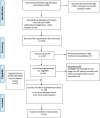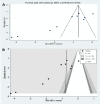The effect of intramuscular injection technique on injection associated pain; a systematic review and meta-analysis
- PMID: 33939726
- PMCID: PMC8092782
- DOI: 10.1371/journal.pone.0250883
The effect of intramuscular injection technique on injection associated pain; a systematic review and meta-analysis
Abstract
Aim: To review the effect of different intramuscular injection (IMI) techniques on injection associated pain, in adults.
Methods: The review protocol was registered on PROSPERO (CRD42019136097). MEDLINE, EMBASE, British Nursing Index and CINAHL were searched up to June 2020. Included studies were appraised and a meta-analysis, where appropriate, was conducted with a random effects model and test for heterogeneity. Standardised mean difference (SMD) with a 95% confidence interval in reported injection pain (intervention cf. control) was reported.
Results: 29 studies were included in the systematic review and 20 studies in the meta-analysis. 13 IMI techniques were identified. 10 studies applied local pressure to the injection site. Of these, applying manual pressure (4 studies, SMD = -0.85[-1.36,-0.33]) and Helfer (rhythmic) tapping (3 studies, SMD = -2.95[-5.51,-0.39]) to the injection site reduced injection pain, whereas the use of a plastic device to apply local pressure to the skin (ShotBlocker) did not significantly reduce pain (2 studies, SMD = -0.51[-1.58,0.56]). Acupressure techniques which mostly involved applying sustained pressure followed by intermittent pressure (tapping) to acupressure points local to the injection site reduced pain (4 studies: SMD = -1.62[-2.80,-0.44]), as did injections to the ventrogluteal site compared to the dorsogluteal site (2 studies, SMD = -0.43[-0.81,-0.06]). There was insufficient evidence on the benefits of the 'Z track technique' (2 studies, SMD = -0.20[-0.41,0.01]) and the cold needle technique (2 studies, SMD = -0.73[-1.83,0.37]) on injection pain. The effect of changing the needle after drawing up the injectate on injection pain was conflicting and warming the injectate did not reduce pain. Limitations included considerable heterogeneity, poor reporting of randomisation, and possible bias in outcome measures from unblinding of assessors or participants.
Conclusions: Manual pressure or rhythmic tapping over the injection site and applying local pressure around the injection site reduced IMI pain. However, there was very high unexplained heterogeneity between studies and risk of significant bias within small studies.
Conflict of interest statement
I have read the journal’s policy and the authors of this manuscript have the following competing interests: JDCR reports personal fees from GSK Pharma, Hologic Diagnostics, Mycovia and Janssen Pharma as well as ownership of shares in GSK Pharma and AstraZeneca Pharma; and is author of the UK and European Guidelines on Pelvic Inflammatory Disease; is a Member of the European Sexually Transmitted Infections Guidelines Editorial Board; is a Member of the National Institute for Health Research Funding Committee (Health Technology Assessment programme); was previously a Member of the National Institute for Health Research HTA Primary Care, Community and Preventative Interventions Panel (2013-2016). He is an NIHR Journals Editor and associate editor of Sexually Transmitted Infections journal. He is an officer of the International Union against Sexually Transmitted Infections (treasurer), and a charity trustee of the Sexually Transmitted Infections Research Foundation. OA and RSH declare no competing interests. This does not alter our adherence to PLOS ONE policies on sharing data and materials.
Figures








References
-
- World Health Organization. WHO guideline on the use of safety-engineered syringes for intramuscular, intradermal and subcutaneous injections in health care settings. 2016. - PubMed
-
- Wynaden D, Landsborough I, Chapman R. Establishing best practice guidelines for administration of intra muscular injections in the adult: a systematic review of the literature. Contemporary Nurse: A Journal for the Australian Nursing Profession. 2005;20(2):267–77. 10.5172/conu.20.2.267 . Language: English. Entry Date: 20060505. Revision Date: 20150820. Publication Type: Journal Article. - DOI - PubMed
-
- Bardal SK, Waechter JE, Martin DS. Chapter 2—Pharmacokinetics. In: Bardal SK, Waechter JE, Martin DS, editors. Applied Pharmacology. Philadelphia: Content Repository Only!; 2011. p. 17–34. 10.1016/j.cbpa.2011.05.033 - DOI
Publication types
MeSH terms
LinkOut - more resources
Full Text Sources
Other Literature Sources
Medical

